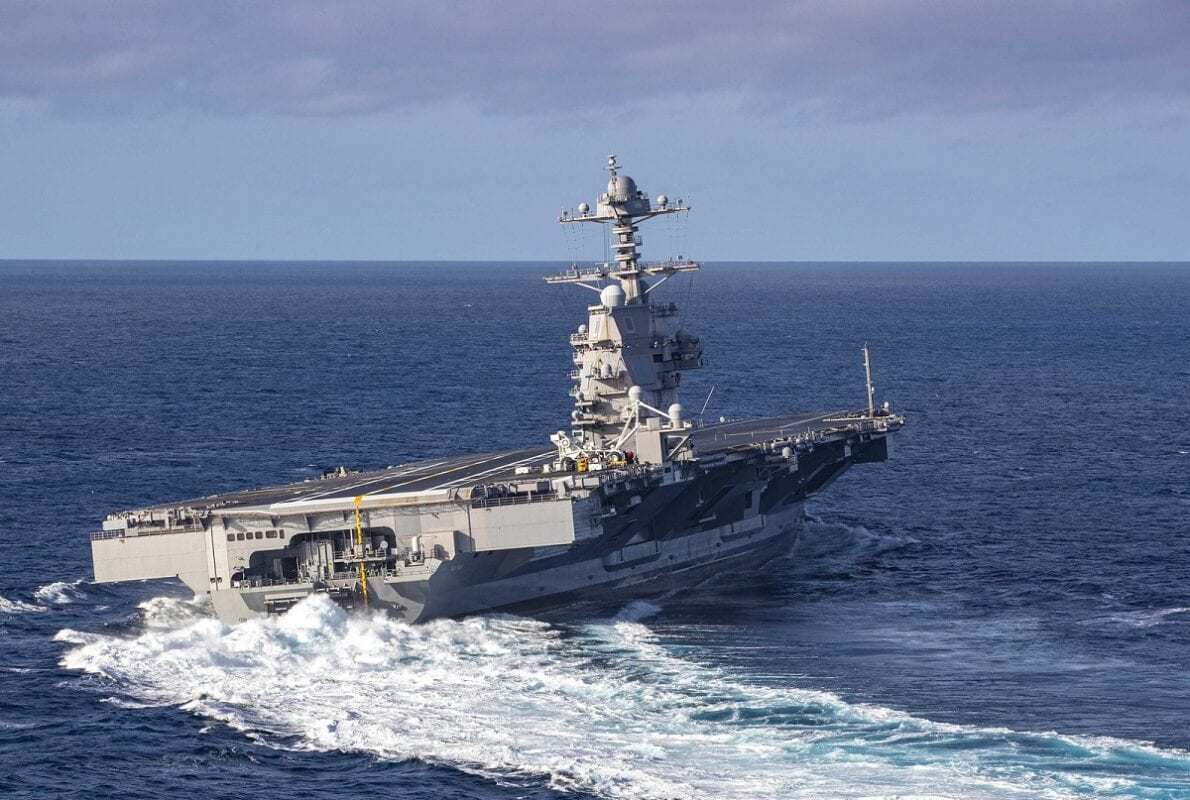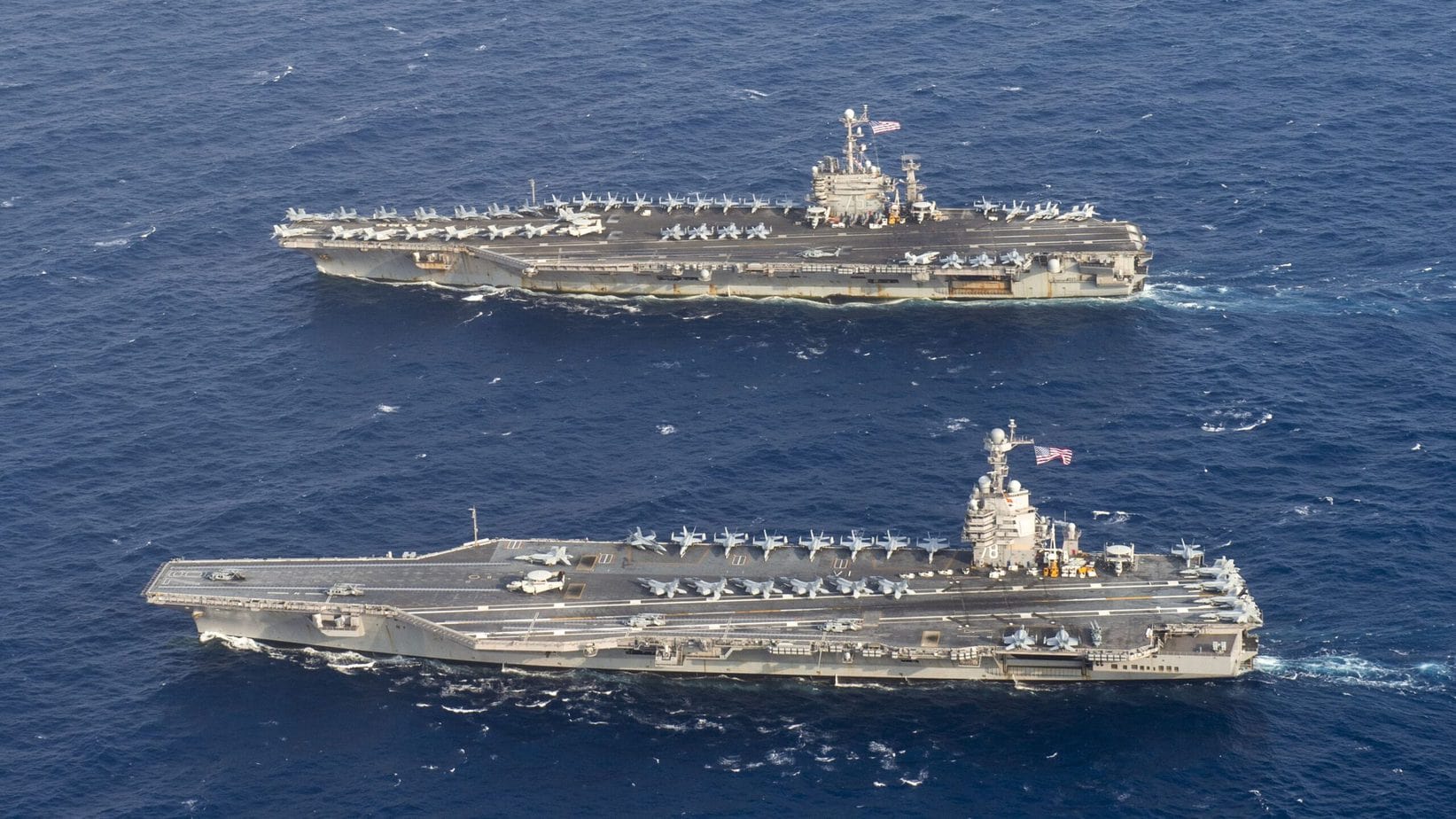This month, the USS Gerald R. Ford, the US Navy’s newest aircraft carrier, successfully completed its shock trials. The third and final 40,000-pound explosive detonated near the Ford’s hull and caused no major injuries, flooding, or fires.
“We had zero catastrophic failures on the ship, zero situations where we had flooding or anything, and zero fires. All that is pretty significant,” Capt. Paul Lanzilotta, the Ford’s commanding officer, told reporters.
The shock trials are the latest milestone for a carrier that has struggled through years of delays and cost overruns — setbacks caused at least in part by the many brand-new systems the Navy chose to put on its newest class of carrier, the service’s top officer said in July.
In an interview at a Navy League event, Chief of Naval Operations Adm. Michael Gilday said the Navy had been too ambitious with the Ford’s new technologies.
“We had 23 new technologies on that ship, which quite frankly increased the risk … of delivery on time and cost right from the get-go.” Gilday said.
“We really shouldn’t introduce more than maybe one or two new technologies on any complex platform like that in order to make sure that we keep risk at a manageable level,” Gilday added.
New technologies
The Force class is meant to modernize carrier operations for a new era, and the 23 new technologies aboard the Ford give it a number of improvements over its Nimitz-class predecessors, including faster aircraft sorties and a smaller crew.
The most well-known additions are the Electromagnetic Aircraft Launch System (EMALS) and Advanced Arresting Gear (AAG).
While the four catapults on board Nimitz-class carriers are steam-powered, Ford’s EMALS uses linear induction motors. The new catapults are more efficient than their steam-powered counterparts and launch fixed-wing aircraft more smoothly and at much faster rates.
The AAG also has advantages over its predecessor, the Mark-7 hydraulic arresting gear.
A turbo-electric system, the AAG has digital controls capable of self-diagnosis and of sending maintenance alerts, requiring less manpower and time to maintain.
The new arresting gear can also handle the weight of a wider variety of aircraft, meaning that the AAG, along with EMALS, will enable Navy carriers to reliably launch and land both manned and unmanned aircraft.
The Ford also features a new elevator system that is designed with larger and more complex smart munitions in mind. The Ford’s 11 elevators are specifically built and positioned within the carrier to decrease the time it takes to move weapons from the ship’s magazines to the flight deck.
Its new Dual Band Radar (DBR) system is capable of simultaneously operating over two frequency ranges. Unlike the system on the Nimitz class, the DBR has no rotating antennas, which increases its reliability and makes maintenance easier.
To top it all off, Ford powers its new systems with two newly designed A1B nuclear reactors that can generate almost three times more power than the A4W reactors used on Nimitz-class carriers.
New problems
The new systems increase the Ford’s capabilities and decrease the number of crew members needed to operate it — about 4,500 compared with the roughly 5,000 sailors and aviators needed aboard Nimitz-class carriers.
But the new technologies have had more than a few problems. The EMALS, for instance, has repeatedly failed, and the AAG has also broken down numerous times.
One AAG breakdown required seven days to fix, while two separate failures once forced individual EMALS catapults offline for three days, according to a report from the Congressional Research Service.
Perhaps the most troublesome system is the elevators, which have plagued the carrier since 2018.
Breakdowns and missed deadlines on the elevators delayed Ford’s first planned deployment, and the carrier had to conduct shock trials without all of them being operational. The Navy now says all 11 elevators will be ready by the end of 2021.
The Ford’s DBR system has also had reliability problems, and plans to include it on the other Ford-class carriers were scrapped in 2015 after its upkeep costs were found to be higher than that of other options.
Some of the problems may have been easier to fix if the Navy had tested the new technologies on land first, Gilday said last month.
“One of the things you learned from the Ford program was the importance of land-based testing on new systems before you introduce them to the fleet,” he said, citing the elevators as a prime example.
Other systems on the Ford have hit milestones during testing on land, and Gilday said the Navy was already dedicating money for land-based testing on its new Constellation-class frigates.
The Ford is also the victim of delays on the F-35C, the carrier variant of the stealth fighter. F-35Cs can operate only on one of the Navy’s 11 aircraft carriers, the USS Carl Vinson.
A capable carrier
Despite the setbacks, the USS Gerald R. Ford is shaping up to be a capable carrier.
Rear Adm. James Downey, the Navy’s program executive officer for aircraft carriers, said the Ford’s development was “well within the projected scope,” and Navy officials are hoping to deploy it in 2022.
In addition to progress on the elevators, the EMALS and AAG systems have improved, with over 8,000 catapult shots and arrested landings conducted on Ford so far.
F-35Cs also deployed for the first time last week aboard the USS Carl Vinson, and the Marine Corps has said its first F-35C squadron is ready for combat. The Navy now plans to reduce the number of F-35C squadrons in each air wing from two to one and increase the number of aircraft in a squadron from 10 to 14.
The issues with the Ford’s development are also lessons for the next three Ford-class carriers: the USS John F. Kennedy, the USS Enterprise, and the USS Doris Miller, which are expected to be delivered in 2024, 2028, and 2032, respectively.
Ford has spent about 50% of the past year at sea, Gilday said last month.

ATLANTIC OCEAN (Oct. 29, 2019) The aircraft carrier USS Gerald R. Ford (CVN 78) conducts high-speed turns in the Atlantic Ocean, Oct. 29, 2019. Gerald R. Ford is at sea conducting sea trials following the in port portion of its 15-month post-shakedown availability.
“So she has more operational time over the past year than nearly any other ship in the fleet, and she’s been performing very, very well,” Gilday said. “We’ve been providing or trying to put her in an environment where she can rigorously test all those systems, and they’ve gone very, very well.”

